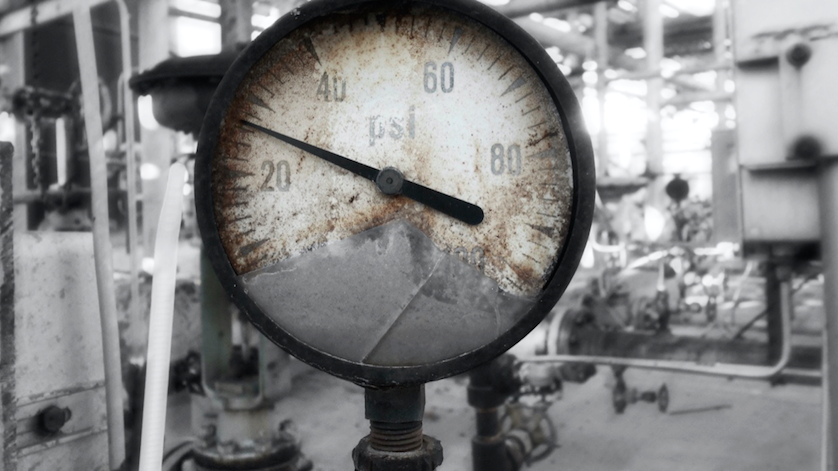
Pressure gauge failure can be attributed to one or more of these eight reasons: mechanical vibration, pulsation, extreme temperature, pressure spikes, overpressure, corrosion, clogging, and mishandling/abuse.
Pressure gauges are an integral part of an application’s warning system. By constantly measuring pressure, these instruments allow users to see how a process is doing. Gauges are sturdy and can handle challenging conditions. However, even the toughest instruments will experience failure if they weren’t designed for a specific application or condition.
At WIKA USA, our customers often ask us why their gauges are damaged or stopped working properly. With decades of pressure experience, we have seen all the causes of pressure gauge failure.
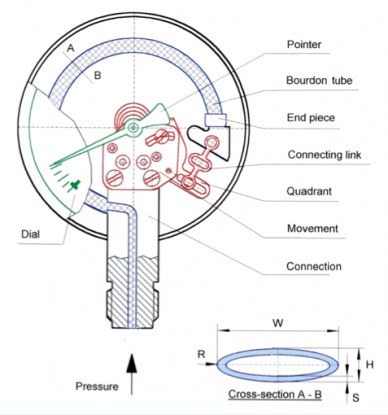
diagram of a Bourdon tube pressure gauge
How A Pressure Gauge Works
Before getting into why things go wrong and how to troubleshoot the problem, it’s important to first understand the inner workings of a mechanical gauge, the most popular of which is the Bourdon tube pressure gauge.
The Bourdon tube is a hollow C-shaped spring element within the case. As the tube is pressurized from the media entering it, it starts to move – like a balloon trying to equalize. This movement is translated through the connecting link, attached to the Bourdon tube via the end piece, into a pressure measurement that the pointer indicates on the dial.
8 Causes of Gauges Failure
When a pressure gauge doesn’t work as expected, the cause can be traced back to at least one of these eight reasons:
1. Mechanical vibration
Numerous studies have shown that vibration is the main cause of pressure gauge failure in manufacturing facilities. Vibration has a negative impact on gauge accuracy in two ways. First, it is difficult to read the pointer on a dial when a gauge is vibrating. Second, incremental damage to the pointer mechanism from vibration can eventually move a pointer off zero, producing inaccurate readings.
Visible signs of mechanical vibration
- Metal filings/dust, like a halo, inside the gauge window from worn pinion and segments gears
- Detached pointer if the vibration is severe
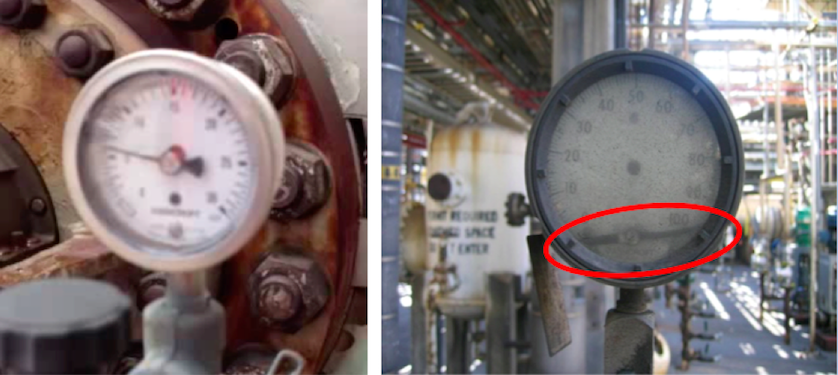
(left) halo inside gauge window; (right) detached pointer
Risks posed by mechanical vibration
- Wear and tear of internal components
- Loss of accuracy/functionality
- Pressure system failure

(left and center) worn pinion gears; (right) worn segment gear
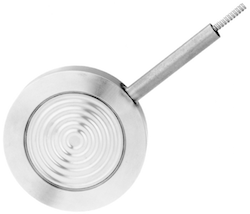
model 990.28 diaphragm seal
Solutions for gauges experiencing mechanical vibration
For most situations, a liquid-filled case is the most convenient and cost-effective way to protect pressure gauges from vibration. The glycerin or silicone-oil case fill acts as a damper to slow down the movement. It also lubricates the pinion and segment gears, thereby reducing wear and prolonging the life of a gauge.
A second solution is to move the gauge away from the source of the vibration. How? Use a diaphragm seal with capillary connection, like the 990.28 cell-type (sandwich) seal. A diaphragm seal can be mounted practically anywhere in the application, and the line allows for remote reading. (See this video and blog for more info on how diaphragm seals work.)
2. Pulsation

pointer flutter
Vibration refers to regular oscillation of mechanical parts. Pulsation, on the other hand, is regular instances of rapid pressure increases and decreases of the media.
Visible signs of pulsation
- Pointer flutter
- Loose or broken pointer in extreme cases
Risks posed by pulsation
- Difficulty in obtaining an accurate reading
- Wear and tear of internal components
- Loss of accuracy/functionality
- Pressure system failure
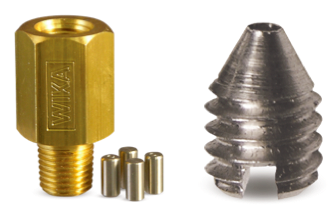
(left) snubber; (right) socket restrictor
Solutions for gauges experiencing pulsation
As with mechanical vibration, a liquid-filled case is an easy solution. So are valves and protective devices like a socket restrictor. This small device has a small orifice to restrict and slow down the pressure of the media before it encounters the gauge. Restrictors are cost-effective and easy to install. Several gauges, like model 111.11 for compressed gas regulators, come standard with a restrictor already threaded into the bore.
For more extreme pulsation, use a snubber or needle valve. Snubbers function like restrictors but come in more material choices, orifice sizes, and psi ratings. Snubbers are also less prone to clogging and are more adjustable in the field, thanks to interchangeable pistons or adjustment screws. Needle valves also throttle the media, thereby reducing the impact of pulsations. These pulsation dampeners are commonly found in pump discharge and boiler house applications.
3. Extreme temperature
Different gauges have different tolerances for extreme temperatures. We look at both ambient temperatures, such as what is found in the Arctic or around a furnace, and the temperature of the process media.

gauge discoloration
Visible signs of extreme temperature
- Dial and/or liquid fill is discolored, usually yellow, orange, brown, or black
- Dial, case, or window is melted – usually because the media is too hot
Risks posed by extreme temperature
- Difficulty in obtaining an accurate reading
- Loss of accuracy/functionality
- Pressure system failure
Solutions for gauges in extreme temperatures
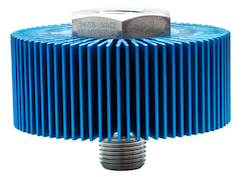
model 910.32.250 mini cooling adapter
A diaphragm seal with capillary allows pressure measurement to occur away from extreme ambient or media temperatures. The longer the run, the more heat is dissipated before the pressure reaches the gauge. Or attach a cooling adapter like the 910.32.200 (up to 500°F/260°C) or 910.32.250 (up to 700°F/370°C). With fins to increase the surface area, these adapters are very effective at radiating and dissipating heat. They’re also extremely easy to retrofit using threaded connections. Pigtail, coil, and mini (rod and cap) siphons use the same principle to dissipate heat.
Glycerin is the typical fill fluid for pressure gauges. For extremely hot or cold ambient temperatures, silicone oil is the better choice as it will not discolor in heat over time or freeze in sub-zero environments.
4. Pressure spikes
Spikes occur when the pressure sharply increases and then suddenly drops. This condition can cause all sorts of problems for gauges not designed for this condition.

bent pointer
Visible signs of pressure spikes
- Bent pointer, like a fishtail or fish hook, from hitting the stop pin too often
- Nicked or broken pointer from hitting the stop pin too hard
- Broken stop pin
Risks posed by pressure spikes
- Increased wear on movement and components
- Loss of accuracy/functionality
- Split Bourdon tube, leading to released media
- Pressure system failure
Solutions for gauges experiencing pressure spikes
As with pulsation, good solutions for dampening the effects of pressure spikes are to use a liquid-filled gauge and/or accessories like restrictors, snubbers, needle valves, or diaphragm seal with capillary. Another way to prevent damaged pointers and internals is to replace the gauge with one that has a higher pressure range. A good rule of thumb is to choose a gauge that is two times the expected pressure maximum. So, if a process typically reaches 500 psi, use one that goes up to 1,000 psi.
For greater reassurance that a gauge never exceeds a certain maximum, attach an overpressure protector to the instrument. This unique option allows the user to changing the maximum pressure setting. If the pressure ever reaches that value, the protector’s spring-loaded piston valve will automatically close, preventing the gauge from experiencing the spike. And when the system pressure drops approximately 25% below pre-set maximum, the valve with automatically reopen.
5. Overpressure

pointer buried against stop pin
This situation is very similar to pressure spikes, but occurs when the gauge regularly measures pressures near or at the maximum range. We typically see this condition in water/wastewater treatment and gas lines.
Overpressure can cause the Bourdon tube to deform and split. This is major problem because a rupture allows caustic media, such as the hydrofluoric (HF) acid in alkylation units, to escape. In pharmaceutical manufacturing, a rupture event ruins very expensive product and leads to shutting down the line, quarantining the product, and re-sterilizing the process.
Visible signs of overpressure
- Pointer buried against stop pin
- Pointer dislodges stop pin
Risks posed by overpressure
- Increased wear on movement and components
- Loss of accuracy/functionality
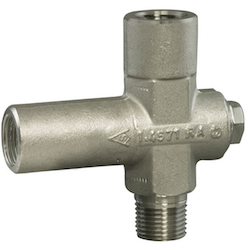
model 910.13 overpressure protector
- Split Bourdon tube, leading to released media
- Pressure system failure
Solutions for gauges experiencing overpressure
As overpressure is similar to pressure spikes, so is the fix: use a gauge with a higher pressure range, and attach an overpressure protector.
6. Corrosion

corroded pressure gauge
Many industries work with harsh chemicals: hydrofluoric acid in refineries, flocculants and chlorine in wastewater treatment, chlorinated gases in fiber optic production, and so on. These media find their way into gauges.
Visible sign of corrosion
- Discoloration and deterioration of the gauge case, pointer, connection, and dial
Risks posed by corrosion
- Loss of accuracy/functionality
- Pressure system failure
Solutions for gauges in corrosive environments
Isolate the gauge from harsh chemicals by using a diaphragm seal made of the appropriate corrosion-resistant materials. WIKA’s diaphragm seals come in a variety of standard and exotic alloys for both the wetted and non-wetted parts: 316L and 316 TI stainless steels, Hastelloy®, Monel®, Inconel®, tantalum, and titanium. The metals can be left as-is or, for extra protection, lined with Teflon® or plated with gold. When deciding on the materials for your diaphragm seals, look at what the existing wetted parts are made of, and choose those.

clogged pressure gauge
7. Clogging
Clogging is an issue for paper plants, wastewater plants, pharmaceuticals, and other industries, as slurry, pulpy, viscous, and high-particulate media can gum up the system.
Visible sign of clogging
- Gauge at or near zero when the system is operating
Risks posed by clogging
- Loss of accuracy/functionality
- Possibility of overpressure
Solutions for gauges measuring clogging media
Again, use a diaphragm seal to separate the gauge from the challenging media. An excellent solution is WIKA’s All-Welded System (AWS), an assembly comprising an XSEL® industrial process gauge permanently welded to a bell-shaped diaphragm seal.
As the AWS still has a small orifice that the media can enter, customers can opt for versions with a flushing port. This component allows operators to clear away media either when clogging occurs or during regular maintenance.
Another solution is WIKA’s INLINE™ diaphragm seals, which has smooth walls for full flow-through. By eliminating dead spaces, there’s no risk of media buildup.
8. Mishandling/abuse
Gauges look sturdy, especially the larger process gauges, but they are not designed to be handles or footholds! During site visits, we often see evidence of gauge mistreatment. Operators might grab on to a gauge as they move around process skids on wheels, or step on them as they climb scaffolding. Not only is this practice unsafe, it increases the chances of gauge damage and failure.

pressure gauges with broken window (left) and cracked case (right)
Visible signs of mishandling/abuse
- Cracked case
- Broken window
- Loss of case filling
- Crooked or bent gauge and/or process connection
Risks posed by mishandling/abuse
- Loss of functionality
Solutions for gauge mishandling/abuse
Training is the best prevention. Employees should be aware of the dangers of mishandling gauges. They should also know how to properly connect gauges. For example, when threading the gauge onto the process, some people tighten it by hand, which risks torquing the case. When the NPT or G connection has a wrench flat area, use a wrench to tighten the gauge.
WIKA USA’s pressure specialists have decades of experience diagnosing why gauges fail, and then coming up with solutions so that instruments last longer. When the causes aren’t obvious, we encourage customers to take advantage of our Instrument Failure Analysis (IFA) program. Send the failed gauge to our facilities in Lawrenceville, Georgia, and our engineers will conduct a full evaluation on the nonfunctioning gauge – all free of charge. Contact WIKA USA for more information about why pressure gauges fail and what you can do to solve the problem.


Good information put together
Very Informative
I have a gauge on a hyd press. It started to read about 500kg on a 6t scale. It has now started to read up to 4t on the scale after use and not return at all. It is liquid filled which l have “vented” with no change.
Excellent
Very informative
Excellent blog and very easy to understand Reasons For Pressure Gauge Failure
Thank you ! very useful information.
Impressive! Thanks for sharing this.
Is it ok for a liquid-filled pressure gauge to be installed in any orientation?
Dear Olivia,
Thank you for your reading our blog “8 Reasons for Gauge Failure”. In general, it is okay to install liquid-filled gauges in any orientation, but there are a couple of things you need to be aware of:
• Pointer shift: If you install the gauge in an angled or horizontal position, you will most likely see a pointer shift at zero especially in larger sized gauges (4” & up) and in gauges without a stop pin. The liquid will push up the pointer. However, this “pointer shift” also applies to dry gauges due to the weight of the pointer.
• Standard liquid-filled gauges are filled at around 90% of the total volume of the case to allow space for liquid to expand, leaving a relatively large bubble at the top of the gauge. This bubble appears to be larger if the gauge is mounted in an angled position and even more so in a horizontal position and might result in an impaired reading.
• In order to compensate for internal pressure, most gauges, especially in ranges ≤ 300 psi, come with a device to vent the internal pressure to atmosphere. WIKA for example uses a so-called “vent-plug” with a yellow lever that you can switch from a “closed” to an “open” position in order to vent the case. It is also recommended to leave the vent plug or push-up pin open during operation to avoid internal pressure to build up. However, if mounted in an angled or horizontal position you cannot leave the vent device in an open position and even a brief venting could result in a spell. An upright position is recommended for gauges that are equipped with pressure relief devices.
WIKA recently launched an innovative option called “Flex Window” in order to compensate for internal pressure. This blog will touch on most issues of standard liquid filled gauges and explains why the “Flex Window” is such an innovative solution.
Best regards,
Hardy Orzikowski
Senior Product Manager
Mechanical Pressure & Temperature
Useful post! I really need this type of article.. this is very useful for me.
Too nice and well written article, much useful and beneficial. Keep posting the valued content like this !
I have a couple glycerin filled gauges where the glycerin is beginning to blacken. I believed it to be a temperature issue however several temperature readings were taken with none being above 70 degrees F (gauge is rated to 200 degrees). Any recommendations?
Thanks
Brian, thank you for reading our blog. At WIKA we rate our Glycerin filled pressure gauges only up to 140°F (60°C) ambient temperature.
The medium temperature is limited to 140°F (60°C) for gauges with brass wetted parts and up to 212°F (100°C) for most gauges with stainless steel wetted parts. It also depends on where the gauges are installed. If they are exposed to direct sunlight it can easily heat up to temperatures way above 140°F depending on the season and location. Unless you have a leak in the Bourdon tube, which would results in other issues (loss of pressure), I can’t see any other reason other than temperature that could cause the Glycerin to change color.
The recommendations also depend on the heat source. If the media is causing the high temperature you might want to use a Syphon (steam application only) or a heat adaptor or cooling element. For exposure to direct sunlight there is not much you can do to prevent discoloration over time, because they are too many factors that could cause discoloration (UV light, chemical reaction with the internal materials etc.). Another reason why we limit our liquid filled gauges to 140°F is due to the expansion of the case filling. Constant exposure at temperatures above 140°F can expand the liquid to a point where it will push out the fill plug and cause a spill.
Best regards,
Hardy Orzikowski
Very informative, excellent article
It’s great information, it helped me, thank you
Would HVAC refrigerant gauges be damaged/go out of calibration by leaving them constantly pressurized?
Thank you for showing interest in our WIKA blog. As long as the pressure is static (no constant cycling). The gauge won’t get damaged.
We do recommend, however, that the pressure does not exceed 75% of the full scale value. The most common cause for damages of HVAC refrigeration gauges is misuse/mishandling (thrown into the truck, bumped against hard surfaces etc.) or exposure to pressure spikes by opening/closing valves very fast. Constant static or steady pressure will not harm the gauge or effect accuracy. Just make sure that the operating temperature (ambient -4°F/140°F, max. media temp. 140°F) does not exceed the temperature limitations of the gauge
Thank you.
Hardy Orzikowski
Senior Product Manager
The very helpful blog we found, most of bloggers I found that they only talk about pressure gauge benefits. but here I know about its failure.
Thanks for sharing informative article, I really like this post.
Hi,
We are manufacturers of CNC MAchine tools in India. Currently having a problem of glycerine filled pressure gauges turning black. Time of reporting the defect ranges anywhere between 10 days to 3 months after manufacture of the gauges.
We are unable to find any clues inside the gauge which is leading to a root cause. Black colour always starts from the top of the gauge. We would like to understand the phenomena.
Best regards
sriram
Dear Sriram,
I am very sorry for the late response, but I have been traveling all of last week. Thank you for reading our blog about the 8 common failure of pressure gauges. In regards to your issue, do you know if the gauge is located next to a heat source? High ambient temperature is the most common reason for the discoloring of the Glycerin but I figure you already know this from reading the blog. What gets my attention is that the discoloring always starts from the top. Again, it could be if the heat source is located close to the top of the gauge. Theoretically it could also come from the black rubber fill plug, but the plug normally does not come in contact with the case fill due to the air pocket. What gauge are you currently using? Do you happen to have pictures from the gauge and the application. If you don’t mind please send me a couple of pictures and I will see if we can come up with an explanation for that phenomenon.
Thanks,
Hardy Orzikowski
To the wika.us admin, Great job!
To the wika.us admin, Your posts are always well-referenced and credible.
Hello, Hardy – I don’t seem to be able to paste a photo here using my phone, but I wanted to show a disassembled liquid-filled Snap-On air conditioning gauge that sat in a box for thirty years or so, in an unconditioned garage. The glycerin(?) leaked, clouded the lens, dissolved the tip of the needle, and formed at least one cc of a brownish soapy solid. Can you explain this?
Thanks,
Andre
Hi Andre,
Does the gauge come with a stop pin and is the stop pin made from metal? Glycerin attracts water and if the case filling mixes with water it can cause a galvanic corrosion if the aluminum pointer touches the metal stop pin over a long period of time. This will also explain the discoloration of the case filling.
Of course there is also a chance that the gauge already came with a Glycerin/Water case filling.
Thanks,
Best regards,
Hardy Orzikowski
Senior Product Manager
Mechanical Pressure & Temperature
It is necessary to have a firm grasp of the primary reasons of pressure gauge failure in order to correctly manage your heating, ventilation, and air conditioning (HVAC) systems. Your essay is a helpful resource for anyone who is dealing with concerns pertaining to pressure gauges because it sheds light on potential problems and solutions to those problems.